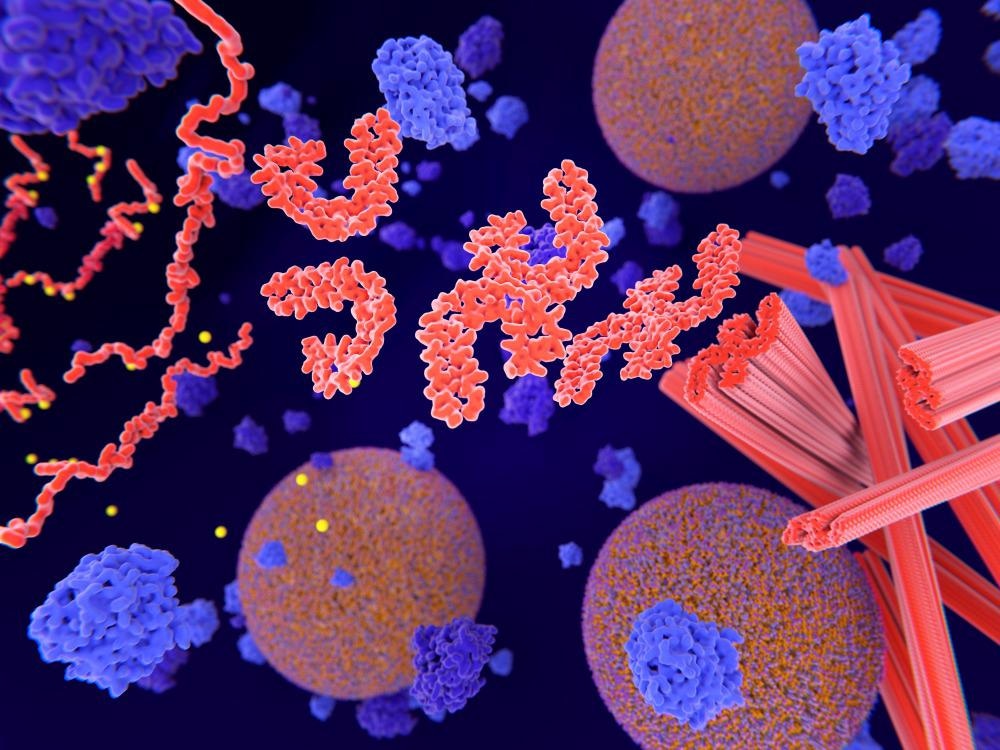By definition, a protein is any type of nitrogenous organic compound that consists of one or more long-chain(s) of amino acids. Proteins are an essential component of all living organisms, as they serve both functional and enzymatic purposes throughout many organs and tissues in the body.

Image Credit: Juan Gaertner/Shutterstock.com
Due to the wide range of functions that proteins have in the body, they are often vulnerable to deleterious effects that can contribute to the establishment of various types of diseases. Some common protein-related disorders can include those that arise as a result of an accumulation of certain proteins, misfolded or aggregated proteins, as well as diseases that arise due to a deficiency of proteins or enzymes.
Misfolded and aggregated protein diseases
The aberrant or misfolding of proteins has been linked to a wide range of diseases that are often classified as either loss-of-function or toxic gain-of-function diseases. For example, a loss-of-function disease can arise due to protein dysfunction that arises as a result of certain mutations like single nucleotide polymorphisms. This type of protein dysfunction can alter the stability of the affected protein, thereby rendering them vulnerable to degradation.
Comparatively, gain-of-function diseases arise due to the aggregation of altered proteins that leads to cellular toxicity. Whereas loss-of-function mutations are often distributed uniformly across the protein sequence, gain-of-function mutations are instead localized to key regions of the sequence. Some of the most notable types of gain-of-function diseases include neurodegenerative diseases like AD and PD, as well as type II diabetes and certain forms of heart disease and cancer.
Accumulation of proteins
Two of the most common neurodegenerative diseases that can affect the elderly are Parkinson’s disease (PD) and Alzheimer’s disease (AD). Like many other types of neurodegenerative diseases, both AD and PD arise due to the accumulation of a specific protein, thus leading these diseases to often be referred to as proteinopathies.
Alzheimer’s disease
The deposition of amyloid-beta peptides, which lead to the development of amyloid and neuritic plaques within the brain, is often a hallmark sign of AD. Amyloid-beta peptides, particularly Aβ42 and Aβ40, are derived from a precursor called amyloid precursor protein (APP) that is expressed as several different isoforms in the brain.
Typically, the two proteins of β and γ secretase will cleave the peptides from APP. However, when this does not occur, amyloid-beta peptides accumulate within various areas of the brain, thereby mitochondrial dysfunction, calcium dysregulation, inflammatory reactions, endoplasmic reticulum (ER) stress, and oxidative damage, all of which contribute to neurodegeneration.
In addition to amyloid-beta peptides, the accumulation of phosphorylated tau proteins within neurons is also a distinct characteristic of AD. Although the abnormal accumulation of these proteins remains unclear, previous studies indicate that the deposition of these tau proteins contributes to synaptic dysfunction and axonal degeneration.
Parkinson’s disease
Sporadic PD is often associated with the accumulation of α-synuclein, which is a small protein that is normally present throughout the brain. Although the normal role of α-synuclein is not fully understood, previous studies indicate that it likely has a role in synaptic plasticity, as well as the vesicular transport and release of neurotransmitters.
Despite the utility of α-synuclein in normal neurological processes, its accumulation in vulnerable regions of the brain could arise as a result of its overexpression from transcriptional and posttranscriptional processes, as well as the reduced degradation of this protein from altered proteasomal and lysosomal pathways.

Image Credit: Jne Valokuvaus/Shutterstock.com
Enzyme deficiencies
Enzymes are a specific type of protein that function by breaking down molecules during metabolism. Typically, the activity of enzymes results in the production of fuel for the body that supports normal growth and development. Therefore, any deficiency in enzymes, which is defined as the absence of these crucial proteins, can lead to a wide range of effects on human health.
Enzyme deficiencies are often referred to as inherited metabolic disorders that arise as a result of genetic defects that are typically inherited from both parents. These metabolic disorders can be classified as those that cause a buildup in harmful amounts of a specific substance that would otherwise be broken down by the enzyme, or a lack/limited amount of the substance.
There are several hundreds of inherited metabolic disorders that have been classified, all of which are due to different genetic defects. Some of the most notable metabolic disorders include Gaucher disease, Krabbe disease, Niemann-Pick disease, porphyria, Tay-Sachs disease, Wilson’s disease, and many others. Some inherited metabolic disorders can be diagnosed through routine screening tests that are performed at birth, whereas others may not be diagnosed until the child or adult begins to develop symptoms of their disorder.
Sources:
- Ganguly, G., Chakrabarti, S., Chatterjee, U., & Saso, L. (2017). Proteinopathy, oxidative stress, and mitochondrial dysfunction: cross talk in Alzheimer’s disease and Parkinson’s Disease. Drug Design, Development and Therapy 11(797-810). doi:10.2147/DDT.S130514.
Further Reading